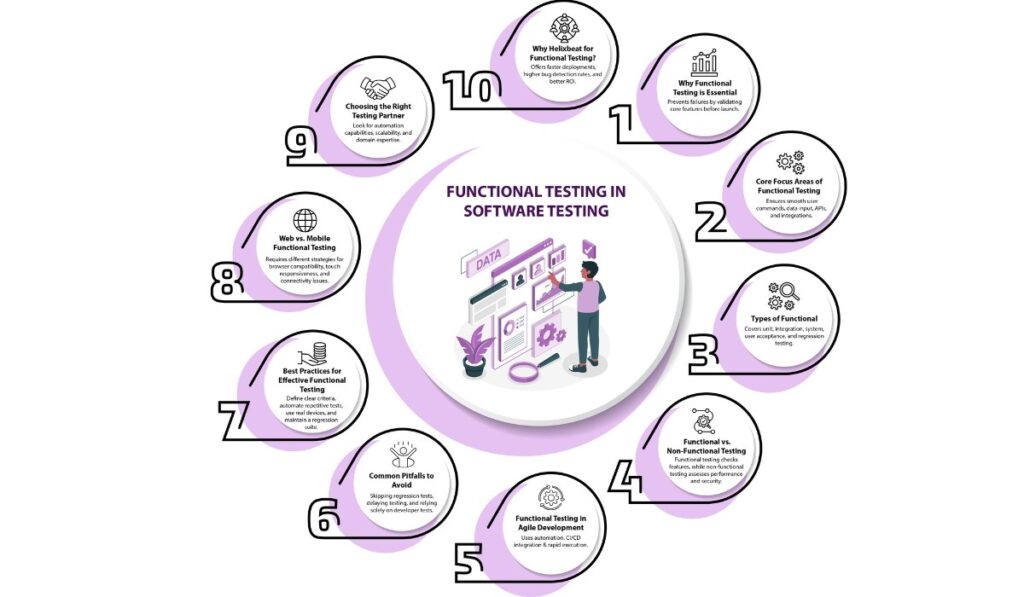Your team has just delivered a long-anticipated product release. Spirits are high, and expectations are even higher. However, shortly after launch, customers begin reporting bugs that disrupt core functionalities. What started as a celebration quickly turns into damage control.
That’s why functional testing in software testing isn’t just a nice-to-have—it’s essential. It helps catch these critical issues before your users ever experience them. And when you partner with a reliable QA provider like Helixbeat, you gain not only faster deployments but also greater confidence in your product’s performance.
Let’s explore why functional testing is a vital part of your QA strategy—and how it differs from non-functional testing in software testing when it comes to ensuring long-term product success.
Table of Contents
What Is Functional Testing in Software Testing?
Functional testing is a type of black box testing where the system is validated against its functional requirements. It answers a fundamental question: Does the software do what it’s supposed to do?
This testing approach focuses on:
- User commands
- Data input
- Business processes
- API interactions
- Integration points
Unlike non-functional testing in software testing, which assesses aspects like performance, scalability, and security, functional testing examines whether individual features behave as expected under specified conditions.
Why It Matters to Business Leaders?
Functional errors disrupt the customer experience and can directly impact your revenue. That’s why functional testing should be viewed as the first line of defense against preventable issues—ones that could damage both your reputation and customer trust if left unchecked.
The Key Types of Functional Testing
Functional testing in software testing includes various layers, each designed to validate specific aspects of your application’s behavior.
1. Unit Testing
Performed by developers during the initial stages, unit testing focuses on individual components or functions to verify they work in isolation. It’s the most granular form of functional testing in software testing and helps catch issues early in the development lifecycle.
2. Integration Testing
Once individual units are tested, integration testing checks how they interact when combined. For instance, when a user signs up, their data should be stored correctly, and a confirmation email should be sent. This testing step ensures seamless communication between modules.
3. System Testing
At this stage, the entire system is tested as a whole against defined requirements. It mimics real-world user scenarios in a controlled environment, offering insights into how the software behaves under actual conditions. This is a core part of functional testing in software testing.
4. User Acceptance Testing (UAT)
This involves real users or business stakeholders testing the software to confirm it meets their expectations. UAT bridges the gap between business goals and technical execution and validates readiness for production.
5. Regression Testing
Whenever updates are made, regression testing checks that new changes haven’t negatively affected existing functionality. It’s especially important in large applications where ongoing changes are common and must be verified thoroughly.
Each of these types complements non functional testing in software testing, working together to build a reliable and user-ready product.
How Does Functional Testing Differ from Non Functional Testing?
Let’s set this straight: functional testing in software testing checks what the system does, while non functional testing in software testing checks how well it does it.
| Testing Type | Focus | Example |
| Functional Testing | Features and usability | Can the user log in successfully? |
| Non Functional Testing | Performance and reliability | Can the system handle 10,000 users simultaneously? |
Both are critical. But without solid functional testing, there’s no point in measuring performance because the features might not even work.
Functional Testing in the Agile World
Agile has accelerated the pace of development, and with that, the expectations from QA teams have grown significantly. With continuous releases and shorter development cycles, relying solely on manual testing is no longer practical or efficient. To keep up, teams need a smarter approach that includes:
- Automated test cases for rapid execution
- Seamless CI/CD integrations for continuous validation
- Reusable scripts that reduce redundancy and save time
By implementing these strategies, functional testing in Agile becomes more scalable, reliable, and aligned with modern development practices. This is where QA partners like Helixbeat bring real value—helping businesses maintain quality at speed, without compromising coverage or confidence.
How Helixbeat Makes Functional Testing Seamless?
Helixbeat’s Testing as a Service (TaaS) model allows teams to integrate testing throughout the development lifecycle. Our approach isn’t just reactive—it’s strategic.
Helixbeat’s Functional Testing Approach
- Dedicated QA teams that scale with your project
- Real-time bug tracking and reporting
- Seamless CI/CD pipeline integrations
- Domain-specific testing expertise in healthcare, fintech, retail, and more
Do you need to add performance or security testing on top? No problem—Helixbeat’s non functional testing in software testing is just as thorough and results-driven.
Tools That Power Precision
From Selenium to JMeter and Appium, Helixbeat leverages a robust stack of 20+ testing tools to deliver fast, accurate, and reliable outcomes.
Common Mistakes Companies Make Without Functional Testing
Even tech-forward companies sometimes underestimate the importance of structured QA. And when functional testing in software testing is skipped or delayed, critical issues often surface at the worst possible time—post-deployment. Here’s what can go wrong:
1. Relying on Developer Tests Alone- While developer-written unit tests are valuable, they often lack the broader user perspective. Functional testing in software testing adds a real-world lens—validating that every feature works as intended across workflows, devices, and user scenarios.
2. Delaying Testing Until After Development- Postponing QA to the end of the cycle creates bottlenecks. Bugs found late are not only more expensive to fix but also disrupt deployment timelines. Early-stage testing, integrated with development, mitigates risk and saves costs.
3. Ignoring Regression Testing- As features scale, the risk of breaking existing functionality increases. Skipping regression tests means bugs from previous versions can quietly resurface. A robust functional testing strategy, supported by automation where needed, helps catch these issues early.
With Helixbeat’s on-demand testing model, you can deploy expert QA teams exactly when needed—supporting both functional and non-functional testing in software testing without delays or added overhead.
Best Practices for Effective Functional Testing
Here’s how to make the most out of your functional testing strategy:
Define Clear Acceptance Criteria
Each feature should have specific, measurable conditions that determine success. This helps testers align their efforts with business goals and validate outcomes effectively.
Automate Repetitive Tests
Automate scenarios that don’t change often—such as login flows, form validations, and standard user workflows. This reduces manual effort while improving test consistency.
Use Real Devices When Possible
Functional testing in software testing must account for real-world usage. Testing across actual devices and browsers ensures your application performs reliably for all users.
Maintain a Regression Suite
As your product grows, older features can break unexpectedly. Maintaining and updating a strong regression suite is crucial to avoid rollbacks and hotfixes.
Helixbeat’s managed testing services help teams implement both functional and non functional testing in software testing, removing the burden of constant test maintenance and improving release readiness.
Functional Testing for Web vs. Mobile Applications
While the core principles remain the same, there are key differences to consider:
Web Apps
- Focus on browser compatibility
- Validate links, forms, and buttons
- Handle multiple screen resolutions
Mobile Apps
- Test across OS versions (iOS, Android)
- Validate touch responsiveness
- Simulate low connectivity scenarios
Helixbeat’s accessibility testing and compatibility testing services ensure that applications behave reliably across all platforms and environments.
How To Choose the Right Functional Testing Partner?
When evaluating partners, ask these:
- Do they offer both functional and non functional testing in software testing?
- Do they support automation?
- Can they scale with your project?
- Do they offer domain expertise?
Helixbeat checks all the boxes and more.
With:
- 99% bug detection rate
- 25% faster release cycles
- 35% boost in ROI
It’s easy to see why 250+ companies trust Helixbeat.
Final Words
Functional testing in software testing is what makes your product truly usable. If core features fail, performance or design won’t matter. It’s the foundation on which every release should be built—whether you’re launching something new or updating an existing platform. While non-functional testing in software testing focuses on performance and security, it all starts with features that work as expected. That’s where Helixbeat comes in. Our agile approach, expert QA teams, and proven testing tools help you release confidently—every time.
Ready to get your product launch ready? Book a demo with Helixbeat and see how quality starts with better testing.

FAQs
1. Is functional testing always manual?
No. Functional testing can be both manual and automated, depending on the use case.
2. What are common tools for functional testing?
Selenium, QTP, JUnit, TestComplete, and Appium are popular tools.
3. When should functional testing begin?
It should begin early, ideally during development, and continue throughout the lifecycle.
4. Why is regression testing important in functional testing?
It helps catch bugs introduced by new code changes.
5. Can functional testing be outsourced?
Yes. Partners like Helixbeat offer dedicated and on-demand functional testing services.














